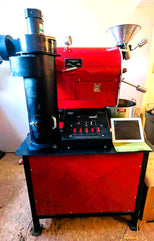
Fresh Coffee Secrets: How Nitrogen Flushing Changes Your Brew
Have you ever opened a packet of coffee and wondered how it smells so fresh? The secret is not magic. It’s a smart method called nitrogen flushing.
Nitrogen flushed coffee may sound scientific, but it’s actually easy to understand. Coffee makers use nitrogen gas to protect coffee from oxygen. Oxygen is what makes coffee lose its taste and freshness quickly. By pushing oxygen out, nitrogen keeps the beans or powder safe.
In this blog, we’ll explore how nitrogen flushing works, why it is used, and some surprising facts about it. You’ll see how this simple trick helps you enjoy coffee that tastes fresh every time.

What is Nitrogen Flushed Coffee?
Nitrogen is a great gas to flush out oxygen from coffee bags that have just been filled with freshly roasted or ground coffee. This process is known as nitrogen flushing (also called gas purging or modified atmosphere packaging).
So, what is nitrogen flushed coffee? It is coffee that has been packed with the help of nitrogen gas. The gas pushes out oxygen from the bag, which helps the coffee stay fresh for a longer time. Oxygen is the main reason coffee turns stale, loses flavor, and smells flat. By removing it, coffee makers make sure you enjoy a rich taste in every cup.
Initially, nitrogen flushing was used in the food industry to protect products like chips from spoilage. Over time, coffee producers adopted this method because maintaining freshness is critical for roasted beans and ground coffee. Today, some larger roasteries also use nitrogen generation systems to provide a steady supply of high-purity nitrogen on-site, supporting packaging, bulk storage, and even nitro cold-brew production. Many suppliers offer nitrogen generators for coffee that are scalable and cost-effective for various production needs.
Nitrogen coffee stays flavorful, smells fresh, and reaches you just like it was roasted yesterday.

Why is Nitrogen Used in Coffee Packaging?
Fresh coffee is very sensitive. As soon as roasted beans or ground coffee meet oxygen, they start to lose flavor and smell. Oxygen causes a chemical change called oxidation, which makes coffee taste bitter and stale. To stop this, companies use a process called nitrogen flushing, often monitored using an oxygen headspace analyzer to ensure minimal residual oxygen.
The Science Behind Nitrogen Flushing
In this method, nitrogen gas is blown inside the coffee bag. The gas replaces the oxygen and pushes it out. Since nitrogen is clean, safe, and does not react with coffee, it protects the beans without changing their taste. Once sealed, the bag has very little oxygen left, so the coffee stays fresh much longer.
Why Nitrogen Works Best for Coffee Packaging
Other gases, like carbon dioxide or argon, are also used in food packaging. But nitrogen is the most popular for coffee because:
- It is odorless and tasteless, so it never changes the coffee flavor.
- It is safe, natural, and makes up most of the air we breathe.
- It keeps bags puffed up, which prevents crushing during shipping.
- It is affordable and widely available.
That’s why nitrogen flushing is the perfect choice to protect your favorite coffee.
Benefits of Nitrogen Flushing in Coffee
Many people ask, Why put nitrogen in coffee? The answer is simple: to keep it fresh, safe, and enjoyable. Nitrogen flushed coffee offers several benefits that protect both taste and quality.

Freshness Preservation
When coffee meets oxygen, it quickly loses its rich smell and bold taste. Nitrogen in coffee removes oxygen and locks in the natural aroma. This way, you can enjoy the same fresh flavor days or even weeks after coffee roasting.
Extended Shelf Life
Normal oxygen coffee spoils fast, but nitrogen flushed coffee can stay good for 6-12 months. The gas slows down chemical changes, which means sellers can deliver fresh products worldwide without losing quality on the way.
Reduced Contamination Risks
Bacteria and mold need oxygen to grow. When nitrogen replaces oxygen, these risks are reduced. This makes nitrogen in coffee packaging a safe method that lowers spoilage and protects your health.
Protection from Crushing
Nitrogen-filled bags look puffed up. This small detail prevents beans or powder from getting crushed during transport. It’s one more way nitrogen flushed coffee arrives in perfect shape at your home.
Better Flavor Experience
By keeping oxygen out, nitrogen helps coffee maintain its original flavor profile. Every sip tastes closer to the way the roaster intended, without the dull or bitter notes caused by staleness.
Cost-Effective Method
Nitrogen flushing may sound complex, but it’s actually affordable. Compared to other preservation methods, it gives long-lasting freshness at a lower cost. So, it is an ideal choice for coffee companies and drinkers alike.
Drawbacks of Nitrogen Flushed Coffee

Nitrogen flushed coffee and K-Cups stay fresh longer because oxygen is removed from the packaging. This keeps the aroma and flavor safe, but the process is not without some challenges.
While nitrogen flushing is helpful, coffee roasteries and offices using K-cups need to consider safety, costs, and maintenance before adopting this method. It works well, but it’s important to know the limits.
- Safety Risks: Nitrogen is odorless and colorless. A leak can reduce oxygen in the room, making it hard to breathe. Always monitor with an oxygen sensor.
- Equipment Costs: Nitrogen flush sealers, cylinders, or generators are expensive. Small roasteries may find the initial investment high.
- Subtle Flavor Benefit: Some say the taste difference is small. Freshness improves, but flavor may not change dramatically.
- Maintenance Needed: Machines need regular checks to stay safe and work correctly.
- Limited Home Use: For home brewers, using nitrogen-flushed K-cups is convenient. But setting up nitrogen systems at home isn’t practical.
The Nitrogen Flushing Process
The method of making nitrogen flushed coffee may look complex, but it follows a clear and simple process. Each step works to protect freshness and stop oxygen from spoiling the flavor.
Step 1: Filling the Bag
Freshly roasted beans or ground coffee are placed into a special food-grade bag. At this stage, the coffee is full of aroma, but it is also at risk because oxygen can make it stale quickly.
Step 2: Nitrogen Injection
A stream of pure nitrogen gas is blown into the bag. This step is called nitrogen flushing. The gas pushes out almost all the oxygen from inside the package.
Step 3: Oxygen Removal
Once nitrogen fills the bag, oxygen levels drop to nearly zero. Without oxygen, harmful oxidation slows down, which means the coffee stays rich in flavor and smell.
Step 4: Sealing the Package
After oxygen is removed, the bag is sealed with a nitrogen flush sealer. It ensures no outside air can sneak back in.
Step 5: Valve Protection
Many bags include a one-way valve. It lets extra carbon dioxide (released from beans) escape while blocking oxygen from entering. This process is called degassing.

Equipment and Techniques Used
It is done using special tools called nitrogen flush sealers. These machines blow nitrogen inside the bag and seal it right away. Some use a single flush, while others use repeated flushing for extra safety.
Nitrogen Flush Sealers: How Do They Work?
These sealers connect to a nitrogen tank. Once the coffee is packed, the sealer releases nitrogen, removes oxygen, and then seals the package in seconds. This quick process makes sure freshness is locked inside.
Packaging with Valves
Many coffee bags have a small one-way valve. It lets extra carbon dioxide (from freshly roasted beans) escape, but it doesn’t let oxygen enter. This process is called degassing, and it keeps the bag safe.
Popular brands like Starbucks, Lavazza, and Peet’s use nitrogen in coffee packaging. It ensures that the coffee you buy still has its rich flavor and aroma.
Alternative Methods of Preserving Coffee Freshness
While nitrogen flushing is one of the best methods for keeping coffee fresh, there are other ways that coffee makers use. These methods also focus on protecting beans from oxygen and keeping the flavor strong.
Vacuum Sealing
In vacuum sealing, all the air is sucked out of the coffee bag before sealing it. It reduces oxygen levels and slows down staleness. It works well for ground coffee but can sometimes crush delicate beans because of the tight packaging.
CO₂ Flushing vs. Nitrogen Flushing
Another method is CO₂ flushing. Like nitrogen, carbon dioxide replaces oxygen inside the bag. However, CO₂ can sometimes affect the taste of coffee if not handled carefully. That’s why nitrogen flushing is more common, it is neutral, safe, and does not change flavor.
Refrigeration and Freezing
Some companies and even home users keep coffee in cold storage. Freezing slows chemical reactions and can preserve beans for a long time. But if not sealed properly, coffee can absorb unwanted smells from the freezer.
Single-Serve Pods
Pods, like those used in Keurig or Nespresso machines, are sealed tightly to protect coffee inside. Each pod keeps out oxygen and moisture until the moment you brew it.
Innovative Technologies
New methods are also appearing. Some brands use protective coatings on beans or advanced packaging films that block oxygen better. Others combine nitrogen flushing with vacuum sealing for double protection.
Many techniques exist, but nitrogen flushing remains the most trusted way to deliver coffee that tastes truly fresh.
End Note
Nitrogen flushing is a clever way to keep coffee fresh, flavorful, and safe. By removing oxygen and protecting the beans, it ensures that every cup tastes just like it was freshly roasted. From nitrogen flushed coffee bags to pods, this method has become the gold standard in coffee preservation.
If you want to learn more about how nitrogen in coffee works or need guidance on choosing the right coffee packaging, Coffeetec can help. Their experts provide clear advice and solutions to keep your coffee fresh and delicious.
Contact Coffeetec today and make sure your coffee stays perfect from the bag to your cup!
FAQs
Is Nitrogen Flushed Coffee Safe?+
Yes, nitrogen flushed coffee is completely safe. Nitrogen is a harmless gas infused in coffee packaging. It replaces oxygen and keeps beans fresh without affecting taste or health. It’s widely used in food preservation.
How long do nitrogen-flushed coffee pods stay fresh?+
Nitrogen-flushed coffee pods can stay fresh for 6 to 12 months, depending on storage. The nitrogen gas keeps out oxygen and moisture, thus it protects the flavor. Always store pods in a cool, and dry place for the best taste.
How to open coffee bags with valves?+
Coffee bags with valves are easy to open. Simply cut or tear along the top seal. The valve is not for opening but for releasing gas, which keeps the packaging residual oxygen low.
How much nitrogen is safe in coffee packaging?+
Food-grade nitrogen (99–99.9% purity) is safe. The goal is to keep residual oxygen in the package below 3%. Ideally around 2% or lower, to preserve coffee freshness and flavor. Since nitrogen is already in the air we breathe, it’s perfectly harmless.


Comments
Leave a comment